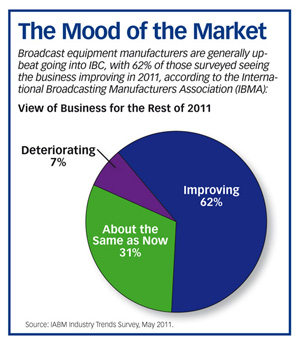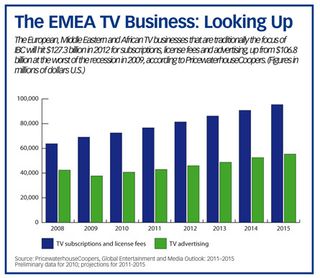Waiting on the Quadrennial Year Bump

Complete Coverage: IBC2011
Attendees left last year's IBC with a growing optimism about a recovery in the broadcast equipment business. The recent turmoil in the global markets aside, that upbeat sense will continue next week at IBC2011, vendors and analysts report.
“Despite all the global doom and gloom, it looks quite good for our industry going into IBC and 2012,” says Peter White, director general for the International Association of Broadcasting Manufacturers (IABM). “[2012] is a quadrennial year with the Olympics and a presidential election in the U.S., and in Europe you have the European [soccer] Championships.”
Even so, the broadcast equipment business will not return to 2008 pre-recession levels until 2012, the IABM predicts. Severity of the downturn can be judged in the fact that many vendors are still losing money, a problem that is likely to produce more mergers and consolidation in the sector.
Close to 80% of IABM’s members were pro! table before the recession, but only half remained pro! table at the bottom of the downturn and pro! tability levels have only recovered to around 65%, White notes.
Worse numbers can be found in North America, which, pre-recession, had the highest proportion of pro! table vendors. About 65% of broadcast vendors slipped into red ink at the worst of the downturn and only 55% are currently making money, White estimates.
“We are now seeing a recovery in North America, and hopefully North America will return to a point where it is once again leading the industry,” White says.
This climate of cautious optimism about the TV industry’s prospects will also continue to play an important role in deal-making at IBC.
Cloud-based solutions, multiplatform delivery, file-based work flows, IP video delivery, improved archiving systems and the ongoing DVB-T2, HD and 3D upgrades will undoubtedly be major issues. But broadcasters are also looking for solutions that reduce operating and capital expenditures.
As a result, many vendors are highlighting the ability of their technologies to streamline work flows, reduce capital expenditures, automate operations, speed the move to less costly IP- and IT-based infrastructures, reduce energy costs, lengthen the life of existing equipment and provide ways to deliver more content to more devices using fewer people.
“Our customers have really been looking for solutions to operate more efficiently and create the capabilities to produce more content with the resources they currently have,” says Jeff Rosica, executive VP, chief sales and marketing officer at Grass Valley, which at IBC will be highlighting a number of newer products designed to improve broadcast operations.
“We’re seeing the market recovery, but perhaps not as fast as people had hoped, and everyone is trying to get more life out of their equipment because capital expenditures are flat if not down,” adds Ben Runyan, director of broadcast marketing at semi-conductor provider Xilinx, which will be showing technology to reduce the cost of equipment or extend its life.
As broadcasters and vendors head to Amsterdam for IBC2011, European markets, which are the traditional focus of the confab, remain relatively healthy despite the Eurozone worries. “Year-on-year growth has been better in Europe than North America,” notes Scott Bosen, director of marketing at Utah Scientific, which is working on major projects in Italy, Spain and Germany. “Despite some of the uncertainty, the big projects seem to be going ahead.”

Part of the European strength may reflect the fact that public broadcasters funded by governments or user fees remain a major component in the TV landscape, making the region more resilient than areas such as North America that are heavily dependent on volatile TV advertising.
Emerging markets are also doing well. “We are seeing a lot of investment in Africa, Eastern Europe, Russia and Latin America,” says Rich Redmond, VP of product management and strategy for transmission at Harris Broadcast Communications. “Brazil is hosting the 2014 World Cup, and that is a huge event for Latin America, so a lot of people are converting to digital for that.”
Specific sectors, such as archiving or technologies for multiplatform and IP video delivery, are also posting above-market growth rates.
Janne Morstol, COO and CFO of T-VIPS—a leading provider in JPEG2000 video contribution and distribution solutions—says that HD upgrades and the move to multiplatform delivery have increased demand for the high-quality video feeds offered by the JPEG2000 format.
While satellite still dominates the contribution market, with about a 60% share, Morstol also sees a growing interest in IP video delivery. “We see that shifting, so that it will be 40% is satellite and 60% is telco, with more and more of the telco going to IP video delivery,” Morstol says.
With improved conditions, some established players are expanding their presence at IBC. Panasonic will operate out of its largestever booth and Ross Video moves into a new, much larger booth in a new hall. “For the first time we will have room to show everything we have,” notes Jeff Moore, executive VP of sales and marketing at Ross Video.
New exhibitors include Broadcast Sports Inc. (BSI). A major supplier of camera systems and wireless broadcast solutions that have been widely used for such events as NASCAR, Indy racing, the World Series, the Super Bowl, and Triple Crown, BSI recently opened a U.K. office and will look to expand its international presence at this year’s conference.
The company has inked deals to supply equipment for the London 2012 Olympics as well as for work with Sky TV in the U.K. for motorway racing, notes Tony Valentino, engineering director at BSI UK. “It will be our first IBC, and we are looking very much to expose the world to the clever technology for broadcast sports that the company has developed in the last 25 years,” he says.
Here are some of the highlights for IBC2011, based on more than 25 briefings with equipment and software vendors.
E-mail comments to gpwin@oregoncoast.com
Broadcasting & Cable Newsletter
The smarter way to stay on top of broadcasting and cable industry. Sign up below










